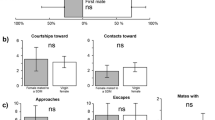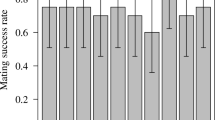Abstract
Sperm competition inBactrocera cucurbitae was studied by double matings of one female with normal and sterile males, with different intervals between the first and the second matings and with or without allowing oviposition after the first or the second mating. When the interval was less than 4 days, the last-male sperm precedence,P 2 , was not different from 0.5, but as the interval was prolonged,P 2 was higher than 0.5. There was no significant difference between treatments in which females were allowed to oviposit after the first mating and only after the second mating. The reason for the higherP 2 when the interval was long was therefore attributed not to sperm usage for egg fertilization during the two matings but, possibly, to sperm mortality. ThatP 2 was 0.5 for shorter intervals suggests that particular sperm replacement mechanisms such as removal and inactivation are absent in B. cucurbitae. Our study is the first to demonstrate a significant effect of short sperm longevity on the last-male sperm precedence.
Similar content being viewed by others
References
Bartlett, A. C., Mattix, E. B., and Wilson, N. M. (1968). Multiple matings and use of sperm in the boll weevil,Anthonomus grandis.Ann. Entomol. Soc. Am. 61: 1148–1155.
Birkhead, T. R., and Hunter, F. M. (1990). Mechanisms of sperm competition.Trends Ecol. Evol. 5: 48–52.
Boorman, E., and Parker, G. A. (1976). Sperm (ejaculate) competition inDrosophila melanogaster, and the reproductive value of females to males in relation to female age and mating status.Ecol. Entomol. 1: 145–155.
Cunningham, R. T., Farias, G. J., Nakagawa, S., and Chambers, D. L. (1971). Reproduction in the Mediterranean fruit fly: Depletion of stored sperm in females.Ann. Entomol. Soc. Am. 64: 312–313.
Gilbert, D. G. (1981). Ejaculate esterase 6 and initial sperm use by femaleDrosophila melanogaster.J. Insect Physiol. 27: 641–650.
Gromko, M. H., Gilbert, D. G., and Richmond, R. C. (1984). Sperm transfer and use in the multiple mating system ofDrosophila. In Smith, R. L. (ed.),Sperm Competition and the Evolution of Animal Mating System, Academic Press, London, pp. 371–426.
Gwynne, D. T. (1984). Male mating effort, confidence of paternity, and insect sperm competition. In Smith, R. L. (ed.),Sperm Competition and the Evolution of Animal Mating Systems, Academic Press, London, pp. 117–149.
Itô, Y., and Yamagishi, M. (1989). Sperm competition in the melon fly,Dacus cucurbitae (Diptera: Tephritidae): Effects of sequential matings with normal and virgin or non-virgin sterile males.Appl. Entomol. Zool. 24: 466–477.
Kakinohana, H. (1982). A plan to construct the new mass production facility for the melon fly,Dacus cucurbitae Coquillett, in Okinawa, Japan. InSterile Insect Technique and Radiation in Insect Control, IAEA, Wienna, pp. 477–482.
Kuba, H., and Soemori, H. (1988). Some characteristics on copulation duration, hatchability of eggs and remating intervals in the melon fly,Dacus cucurbitae Coquillett (Diptera: Tephritidae).Jpn. J. Appl. Ent. Zool. 32: 321–324 (in Japanese with English summary).
Nakamori, H., and Kakinohana, H. (1980). Mass-production of the melon fly,Dacus cucurbitae Coquillett, in Okinawa, Japan.Rev. Plant Prot. Res. 13: 37–53.
Parker, G. A. (1970). Sperm competition and its evolutionary consequences in the insects.Biol. Rev. 45: 525–568.
Pyle, D. W., and Gromko, M. H. (1978). Repeated mating by femaleDrosophila melanogaster: The adaptive importance.Experientia 34: 449–450.
Teruya, T., and Isobe, K. (1982). Sterilization of the melon fly,Dacus cucurbitae Coquillett Yamagishi, Itô, and Tsubaki. (Diptera: Tephritidae), with gamma-radiation: Mating behaviour and fertility of females alternately mated with normal and irradiated males.Appl. Entomol. Zool. 17: 111–118.
Tenrya, T., Zukeyama, H., and Itô, Y. (1975). Sterilization of the melon fly,Dacus cucurbitae Coquillett, with gamma radiation: Effect on rate of emergence, longevity and fertility.Appl. Entomol. Zool. 10: 298–301.
Teruya, T., Nishida, K., Tao, M., and Kuba, H. (1985). Cytological identification of testes from native and irradiated melon flies,Dacus cucurbitae Coquillett (Diptera: Tephritidae).Okinawa Nôgyô 20: 31–37 (in Japanese with English summary).
Tsubaki, Y. (1988). Mating system of insects. In Higashi, K., Ubukata, H., and Tsubaki, Y. (eds.),Dragonfly Mating Systems, Tôkai-Daigaku Shuppan-kai, Tôkyô, pp. 246–285 (in Japanese).
Tsubaki, Y., and Sokei, Y. (1988). Prolonged mating in the melon fly,Dacus cucurbitae (Diptera: Tephritidae): Competition for fertilization by sperm-loading.Res. Popul. Ecol. 30: 343–352.
Tsubaki, Y., and Yamagishi, M. (1991). “Longevity” of sperm within the female of the melon fly,Dacus cucurbitae (Diptera: Tephritidae), and its relevance to sperm competition.J. Insect Behav. 4: 243–250.
Walker, A. (1980). Sperm utilization strategies in nonsocial insects.Am. Nat. 115: 780–799.
Wilkes, A. (1966). Sperm utilization following multiple insemination in the waspDahlbominus fuscipennis.Can. J. Genet. Cytol. 8: 451–461.
Yamagishi, M., and Tsubaki, Y. (1990). Copulation duration and sperm transfer in the melon fly,Dacus cucurbitae (Diptera: Tephritidae).Appl. Entomol. Zool. 25: 517–519.
Zimmering, S., and Fowler, G. L. (1968). Progeny: sperm ratios and non-functional sperm inDrosophila melanogaster.Genet. Res. 12: 359–363.
Author information
Authors and Affiliations
Rights and permissions
About this article
Cite this article
Yamagishi, M., Itô, Y. & Tsubaki, Y. Sperm competition in the melon fly,Bactrocera cucurbitae (Diptera: Tephritidae): Effects of sperm “longevity” on sperm precedence. J Insect Behav 5, 599–608 (1992). https://doi.org/10.1007/BF01048007
Accepted:
Issue Date:
DOI: https://doi.org/10.1007/BF01048007




